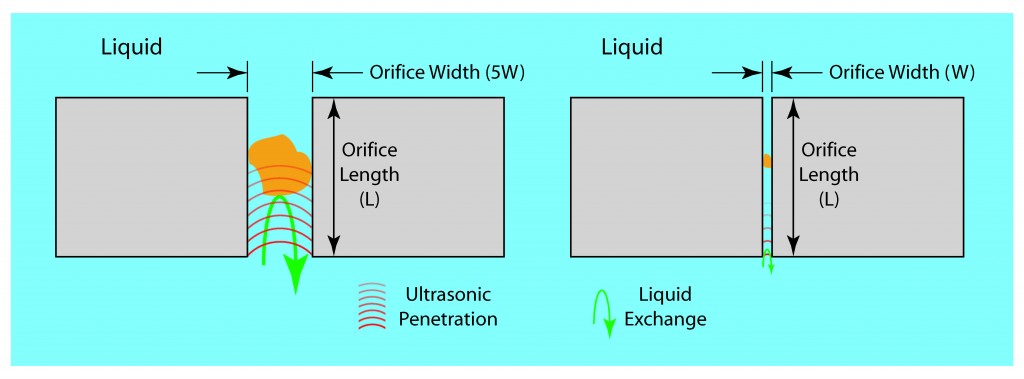Dimensions of orifices and typical contaminant scenarios were discussed in preceding blogs. Today, let’s consider the role of ultrasonics in removing contaminants from orifices. First, we’ll consider the “classic” orifice consisting of a passageway through a solid. Then we’ll talk about some special cases which can have an impact on the ability of ultrasonics and other mechanisms to remove contaminants from these orifices.
The “classic” orifice as we have defined it earlier is a passageway through an otherwise solid piece of material which has both a length and a width and is open on both ends. Cleaning using spray washing, for example, can be quite effective at removing liquid contaminants. Once the bulk of the contaminating liquid is removed, continued flushing driven by the pressure of the spray completes the cleaning process. Removing a solid contaminant, however, presents a greater challenge. The smaller the orifice is, compared to its length, the greater the challenge. This is because mechanical energy must be delivered and/or an exchange of liquids must occur at the location of the contaminant.

If the width of the orifice is large, delivering mechanical energy and an exchange of liquid are relatively easy as shown in the illustration above. As the ratio of width to length decreases, the difficulty of cleaning increases accordingly.
Ultrasonic energy produces two mechanisms that can be effective in removing contaminants from an orifice. The first is ultrasonic cavitation. If the width of the orifice is large enough to accommodate a cavitation bubble (about .001″ at a frequency of 40kHz) then cavitation can occur within the orifice to enhance cleaning. The depth of penetration of cavitation events will vary depending on the size of the orifice and the frequency and power of the ultrasonic energy. As we’ve discussed in previous blogs, higher ultrasonic frequencies produce smaller cavitation bubbles. The second mechanism is the effect of pressure waves that can penetrate much greater distances than actual cavitation within a long orifice to enhance cleaning. These pressure waves can also penetrate orifices that are curved or angled. As the depth of the orifice increases the effect of cavitation and pressure waves decreases as energy decays over distance and is absorbed by the surrounding solid material. The ratio of length to width of an orifice that can be effectively cleaned using ultrasonics varies with ultrasonic power, frequency and the nature of the material surrounding the orifice.
Although the length of an orifice that can be cleaned using ultrasonics is limited in the classic case, there are special cases where orifices of nearly unlimited length can be cleaned ultrasonically. In these cases, the orifice, rather than penetrating a solid with some thickness, is surrounded by only a thin wall of material that will conduct ultrasonic energy. These special cases include things like hypodermic needles, glass tubing and thin-walled metallic or ceramic tubing. In these cases, ultrasonic energy can be delivered through the wall surrounding the orifice to produce mechanical effects including ultrasonic cavitation within the orifice independent of its length. The tube is simply immersed in an ultrasonically activated liquid. A flow of liquid through the thin-walled orifice is, of course, required to clear the loosened contaminants from the interior of the orifice.
In summary, one must consider both the Width to Length ratio of an orifice and its overall size to determine cleanability. Cleanability increases as the Width to Length ratio increases. Larger orifices are more easily cleaned than smaller ones due to better accessibility within the orifice. The cleaning of orifices with thin walls that conduct ultrasonic energy is often possible in cases where an orifice with the same Width to Length ratio through a solid material would not be possible. This is due to the ability to introduce ultrasonic energy through the conductive wall to deliver mechanical energy to its interior.
– FJF –



 English
English Spanish
Spanish Chinese
Chinese Canada
Canada Mexico
Mexico United Kingdom
United Kingdom



